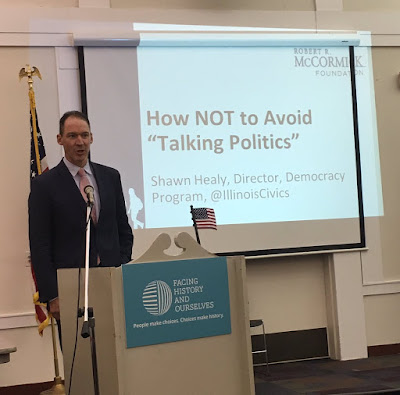How NOT to Avoid "Talking Politics"
by Shawn P. Healy, PhD, Democracy Program Director
Last Tuesday, I had the honored of speaking at a community forum in Chicago’s 47th Ward sponsored by partner and grantee Facing History and Ourselves. It was titled “How NOT to Avoid ‘Talking Politics’,” and my remarks are excerpted below.
According to Hill’s Manual of Social and Business Forms, a guide to writing and etiquette from 1879, we should “…not discuss politics or religion in general company. You probably would not convert your opponent, and he will not convert you. To discuss those topics is to arouse feeling without any good result.”
Today’s program will test the wisdom of this time-honored adage.
The truth is that most of us don’t discuss politics at all, and when we do it’s with people that share similar ideological views. These like-minded conversations can lead to ideological amplification, where there is even less diversity in political opinions on the issues of the day post-deliberation.
Consider an experiment conducted in Colorado where liberal residents of Boulder and conservative residents of Colorado Springs were assembled to discuss global warming, affirmative action, and civil unions for same-sex couples. Not only was there more consensus on these issues within groups, anonymous statements by individual members reflected more extreme views.
And these scenarios are liked replicated every day in the 47th Ward, City of Chicago, selected suburbs, and most certainly downstate. Bill Bishop first made the case that we’re sorting ourselves ideologically by where we choose to live in a widely cited 2008 book, The Big Sort. There he documented the growth in landslide counties that favored one presidential candidate over the other by more than 20 percentage points. While they were scant in the fiercely fought 1976 election between Carter and Ford, they multiplied seven cycles later in the narrow 2004 Bush victory over Kerry.
Landslide counties have proliferated over the last quarter century; and it won’t surprise you that these trends only continued in 2016, where a full 60% of all counties now fall in this category.
Republicans won 9 times as many of these counties as Democrats, but the latter have an iron grip on big cities like Chicago. And Illinois is not immune from these trends in ideological polarization. Previously you count on diehard Democrats in Chicago and rock-ribbed Republicans in the surrounding suburbs, with statewide elections swinging on the up-for-grabs downstate vote. Chicago remains a constant and downstate is now bright red with the exception of university towns and East St. Louis. The suburbs are the one place where there’s a politically heterogeneous population.
Today’s program will test the wisdom of this time-honored adage.
The truth is that most of us don’t discuss politics at all, and when we do it’s with people that share similar ideological views. These like-minded conversations can lead to ideological amplification, where there is even less diversity in political opinions on the issues of the day post-deliberation.
Consider an experiment conducted in Colorado where liberal residents of Boulder and conservative residents of Colorado Springs were assembled to discuss global warming, affirmative action, and civil unions for same-sex couples. Not only was there more consensus on these issues within groups, anonymous statements by individual members reflected more extreme views.
And these scenarios are liked replicated every day in the 47th Ward, City of Chicago, selected suburbs, and most certainly downstate. Bill Bishop first made the case that we’re sorting ourselves ideologically by where we choose to live in a widely cited 2008 book, The Big Sort. There he documented the growth in landslide counties that favored one presidential candidate over the other by more than 20 percentage points. While they were scant in the fiercely fought 1976 election between Carter and Ford, they multiplied seven cycles later in the narrow 2004 Bush victory over Kerry.
Landslide counties have proliferated over the last quarter century; and it won’t surprise you that these trends only continued in 2016, where a full 60% of all counties now fall in this category.
Republicans won 9 times as many of these counties as Democrats, but the latter have an iron grip on big cities like Chicago. And Illinois is not immune from these trends in ideological polarization. Previously you count on diehard Democrats in Chicago and rock-ribbed Republicans in the surrounding suburbs, with statewide elections swinging on the up-for-grabs downstate vote. Chicago remains a constant and downstate is now bright red with the exception of university towns and East St. Louis. The suburbs are the one place where there’s a politically heterogeneous population.
Read the entire speech.





Comments
Post a Comment